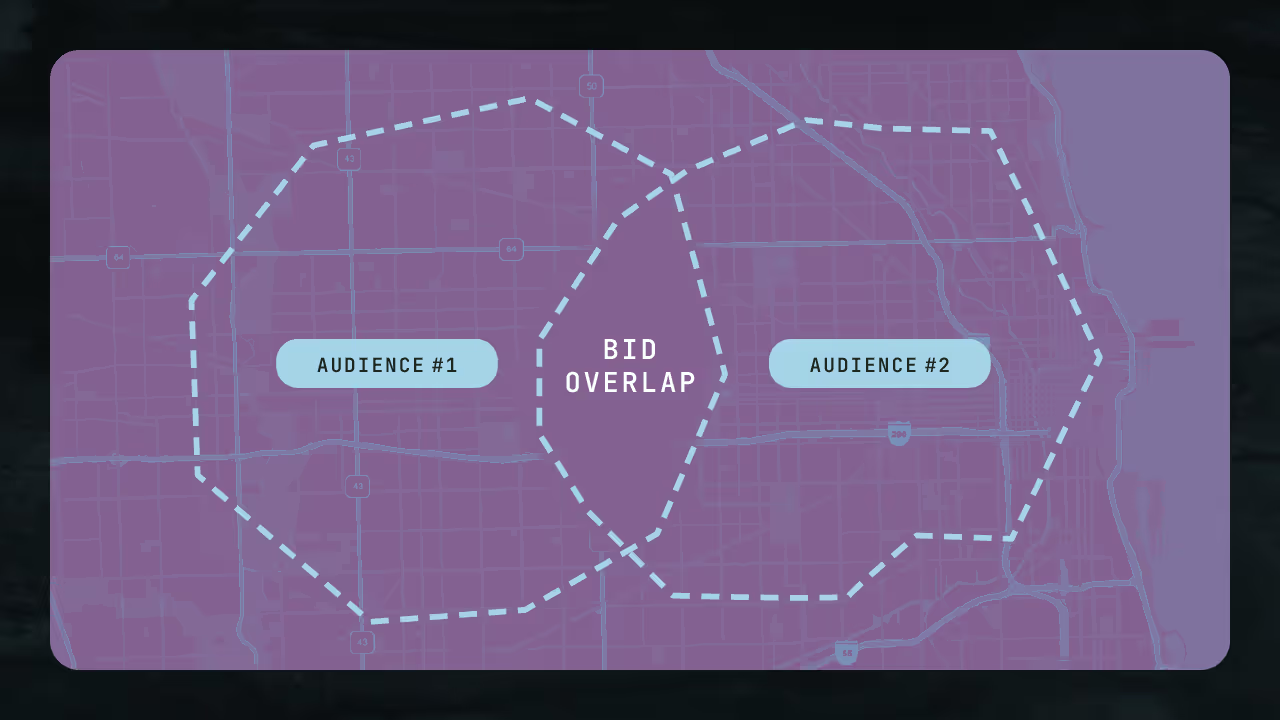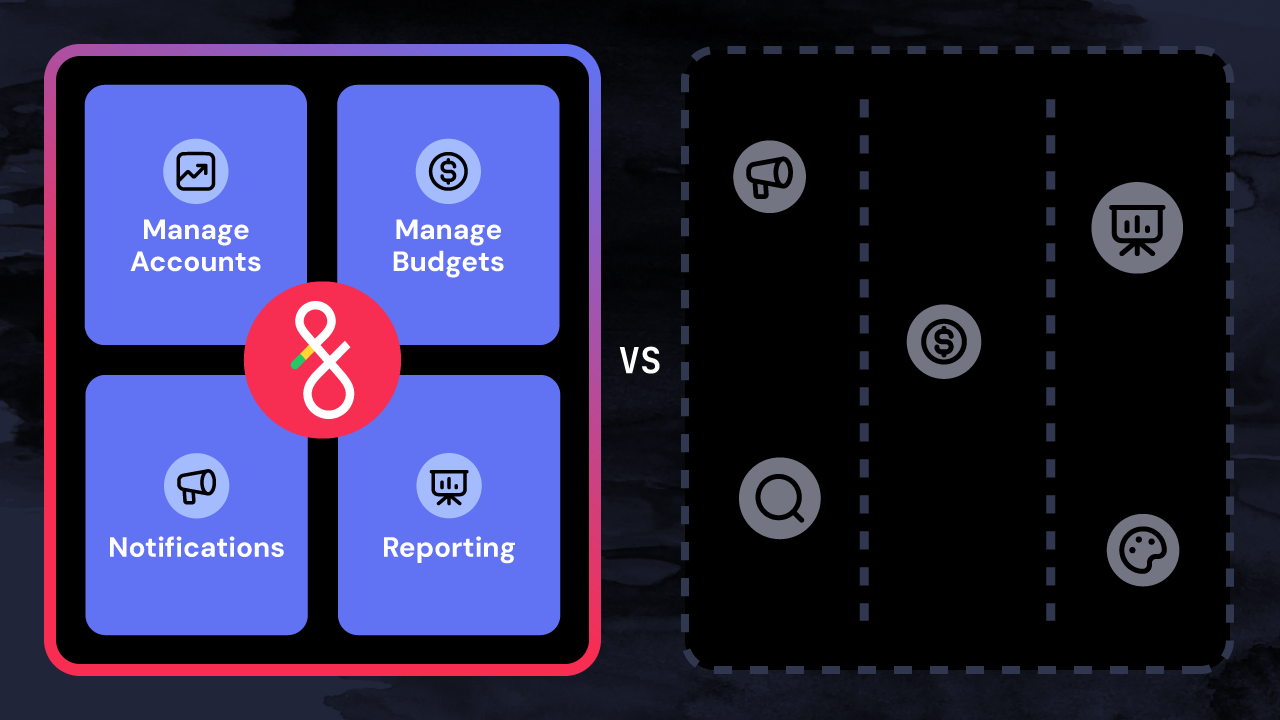Precise audience and campaign targeting is a must to drive results. Matching the right promotion, message, or tone to localized audiences has been proven to drive better results time and time again.
However, building and managing precise targeting strategies across multiple channels is a labyrinthine task. It’s complex, time-consuming, prone to mistakes, and impossible to pull off at scale.
Automation enables teams to streamline targeting workflows, eliminate internal competition, and deliver highly relevant ads with speed and accuracy. It's a must for companies managing multi-location advertising campaigns at scale.
Whether your teams are managing 40 locations or 400, automation can give your agency greater precision and more control when building location-based targeting strategies.
Prevent campaign overlap with automated location-based targeting
Audience and campaign overlap occurs when you're targeting the same audiences with different messages or ad campaigns. When consumers are included in multiple audience segments or campaigns, it can ad hinder performance and drive up costs as you "outbid" yourself. It's a common problem for advertisers running targeted multi-location campaigns, and yet, most geo-targeting solutions don’t allow you to get more precise than a target audience’s city or zip code.
Managing all your multi-location advertising workflows out of one interoperable system enables precise control of location targeting syntax., eliminating wasted spend and helping align your geotargets. This means you can better manage competition between accounts, saving clients money by ensuring you’re not wasting budget outbidding yourself for key audiences.
For example, Fluency’s Digital Advertising Operating System offers two ways to mitigate internal competition between locations within the same geographic region. Aligned targeting eliminates competition between accounts with nearby business locations, while localized targeting fine-tunes strategies within the same account.
- Aligned targeting: Aligned targeting prevents competition between accounts with nearby business locations. The system looks for campaigns that have the same name in other accounts. If targeting overlaps are found, the system gives preference to the zip codes closest to each business location by applying negative bid modifiers to the overlapping zip codes from the other account.
- Localized targeting: While aligned targeting spans accounts, localized targeting is for the same account. Simply add a tag for a specific address element (e.g. street, city, state, etc.) in your campaign name to create a campaign specific to your audience’s location. If the system identifies a targeting overlap, it gives preference to the business location closest to the overlapping zip code(s) by applying negative bid modifiers to overlapping zip codes.
Assigning negative bid modifiers to overlapping zip codes ensures that your agency can strategically serve the most relevant ads to finely tuned audiences. In addition to reducing competitive spend between campaigns for multi-location customers, you are more likely to improve a campaign’s relevance, driving up click-through rates and conversions.
Automate bulk updates for local promotions across multiple campaigns
Building, launching, and managing promotional ad campaigns with automation gives you unprecedented accuracy and efficiency. Automation tools can push consistent changes to multiple ad sets at once, reducing errors and freeing up time for strategy by performing intricate “do” or “do not” tasks based on specific qualifying conditions at a nearly infinite scale.
The problem with using individual publisher tools to manage multi-location campaigns on multiple channels is that it forces you to be single-task oriented, draining your productivity. For example, you can’t just copy-paste your targeting and asset setups from Meta over to Google. Messing up different promotions could have dire consequences: if a prospect expects an offer that can’t be delivered, it looks bad on both your customer and your agency.
Rather than building out nuanced audiences for every channel, you can use automation to set up specific audience parameters and associated assets in one place for all your channels. Then, with one click, you can push these parameters out across every channel. (Bonus: if certain conditions aren’t met or if errors are detected, the system notifies you of the problem so you can address it quickly.)
You can also manage promotional advertising elements in bulk. For example, you can swap specific words or phrases with new ones across every channel, campaign, or ad set from one place instead of finding and changing every instance. The same bulk ad editing capabilities exist for any images, photo frames, headlines, keywords…basically, if you can swap it out manually, then you can swap it out with automation.
These bulk automation features also make testing easier. Maybe your customer wants to learn if a percentage discount drives more leads than a specific dollar-off discount. With automation and bulk multi-channel editing solutions, you can set up promotional tests quickly and easily. Most importantly, because building and launching tests on multiple channels is so quick and easy, you can get feedback faster than if you set up each test manually.
Level up: safeguarding your promotional campaigns with evergreen defaults
Promotions aren’t evergreen, either. When one sale ends and another begins, you’ve got to swap everything out and get the new content up—across every channel, campaign, and ad set. Ugh.
Fluency’s Digital Advertising Operating System includes safeguard features that enable you to simultaneously turn one promotion off when another turns on.
Plus, if something is missed for any reason, you can set a default, universal “evergreen” campaign to run whenever turnovers take place. This becomes especially valuable during high-pressure periods, such as the Q4 holiday season, when promotional activity makes your AdOps teams feel like they’re stuck in a pressure cooker.
The system can even notify you if something seems off, like if a campaign is still running ads with “Black Friday” copy in the first week of December.
Scale localized ads automatically with direct data source integration
Automation enables you to dynamically adjust copy, promotions, and creative assets to match specific audience preferences. With automation, you can pull in unique, location-specific data points (e.g. addresses, phone numbers, hours of operation, promotional offers, storefront photos, etc.) as you build ads, enabling you to launch highly targeted multichannel campaigns at scale.
Today’s audiences expect ads, offers, and content to be relevant and catered to their interests. A lot of agencies have everything they need for targeting audiences, but activating this data for different locations or offers…well, that’s a whole different challenge.
Integrated advertising systems, which bring all your data sources together into one single place, make it possible to pull data fields directly into ad builds with automated workflows. This includes first-party data as well as third-party data from publishers. Working out of one data hub, where all your different data sources are structured and tagged, makes it readily available for rapid use.
What does this look like in practice? Let’s say your customer wants to run different regional promotions across 100 franchise locations. They want to make sure each ad includes specific promotional copy, the location’s phone number, and specific images that ensure franchise brand consistency. They’ve provided you with a spreadsheet that lists all the relevant locations, associated phone numbers, and the promotion that’s supposed to run.
Manually programming 100 different promotional campaigns across multiple channels is a huge waste of time and effort. Instead, a system like Fluency pulls in the data directly from the data source, tags it, and makes it usable for ad builds. As such, you can build targeted ads with tags acting as your building blocks:
“Limited time offer! [Promotion]! Call [phone number] to claim yours now.”
If your data source changes—for example, if a location wants to run a different promotion—the ads automatically sync any source data changes to your live ad sets. This saves you countless hours of updating and changing ads (it’s estimated that AdOps professionals spend 46 hours every month just making manual adjustments to existing campaigns).
Working in this way allows you to build, run, and manage data-powered and highly-targeted campaigns at scale that saves you hours of manual work.
How agencies can prepare for automated location targeting workflows
Advertisers focusing on multi-location strategies need to ask themselves hard questions that break these problems down into manageable pieces:
- Are your promotional workflows designed for scale? Can changes be applied across locations quickly, or is it a manual grind every time?
- Is your data structured and ready for activation? Are valuable data points like inventory, offers, and contacts easy to access and plug into campaigns or ad sets?
- How well-defined is your targeting strategy? Do you understand where audiences overlap, and do you have a framework in place to prevent internal competition?
With automation and integrated data systems, you can create strategies that are both coordinated and effective. These solutions make it possible to bring every piece of your advertising ecosystem together for fluid, seamless workflows and location-based targeting strategies.
When you take a step back, all of these workflows help your team overcome a common advertising operational pain point: capacity. You want your advertising strategies to be precise, personalized, and scalable, but all three efforts require enormous time and effort when tackled manually.
These targeting strategies share another common thread. They all highlight the importance of well-structured data at an agency-wide level. If your promotions, audience data, and targeting strategies aren’t organized in an operationally scalable way, even minor inconsistencies can snowball into big-time losses.
By addressing these foundational data problems, you open the door to better strategies, more engaging campaigns, and a team that has the bandwidth to think big. It’s not easy, but it’s worth the effort.
Best practices for automating location-based campaigns
Automating your localized ad campaigns can help you deliver the right messages to the right audiences, all with a lot less work and fewer errors. Here are some best practices to keep in mind as you bring automated workflows into your targeting strategies:
- Make sure your data is centralized and structured: Location-specific data, like addresses and contact information, should be stored in a structured format that makes tagging simply. Data consistency and structure is key for integrating data fields directly into automated workflows.
- Look for ways to insert dynamic content: Automation makes it possible to plug location-specific copy or assets directly into your ad builds. Adding city names, local offers, or even store hours can ensure your ads speak to the right audiences.
- Combine signals for advanced geo-targeting: Zip codes don't always cut it. Get creative with your audience segments by combining first-party data (like demographics) with real-time location signals to run hyperlocal campaigns specific to your consumers.
- Test, test, test: Automation makes it easier to set up A/B tests with localized messaging and creative assets. Using a Digital Advertising Operating System can feed real-time performance data back into the system for AI to analyze and provide refinements that maximize ROI.
Simplify targeting workflows with automation for better performance
Targeting different audiences for multi-location companies is inherently complex. But complexity doesn’t have to mean chaos. With the right mix of data organization, strategy, and advanced operational tools, your agency can execute and manage immensely complex campaigns with speed and confidence.
At the end of the day, advertising at scale isn’t about doing everything for every location. It’s about making your efforts cohesive, focused, and undeniably effective. Eliminating your operational bottlenecks with Fluency’s automation tools means your teams can deliver timely, relevant ads for any number of accounts, locations, or channels.
Building a strong data foundation is key if you and your team are going to gain the capabilities required to act upon the latest advertising data trends or develop advanced data-powered advertising strategies at scale. We’ve helped dozens of agencies structure and organize their advertising data for activation. If you want help figuring out the next steps your agency needs to take on your path to automated workflows, let’s chat.






